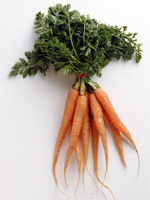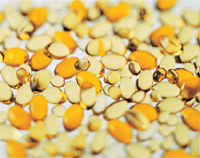Yeasts are common in our bodies, particular the Candida family, and an overgrowth (Candidiasis) can lead to a number of serious illnesses including cancer; yeasts can also set up the conditions for cancer to grow and to spread.
Yeast, fungus, moulds - from gut problems to cancer
There are over 60 members in the Candida family, with Candida albicans the most common inhabitant of the human body. It is present at low levels everywhere. (This article has been updated several times since the original 2007 article. Chris Woollams)
Candida albicans is a regular member of the human flora on the skin, in the GI tract and the genitourinary tract. But C albicans and other family members can easily grow from a 'presence' in the body to infection levels. Fungal infections are yeast infections. Candidiasis is a fungal infection. Oral candidiasis can result in thrush in the mouth or mouth ulcers. Cutaneous candidiasis can cause white or red patches on the skin. Urinary and Vaginal yeast infection can lead to thrush and UTIs.
Other Candida family members are almost as common as C albicans, for example Candida glabrata and Candida parapsilosis.
Candida tropicalis are participants in Crohn's disease. A study showed that foods you eat can cause inflammation and the disease (6). As long ago as 2005, yeast expert Gerald Green believed Candida albicans was linked to a host of gut illnesses such as IBS,
Chris is clear that Candida can be both a direct and indirect cause and also a 'proliferator' of cancer. Indeed, there is research on people with Candidiasis having a significantly higher risk of all cancer, and especially head and neck cancer, pancreatic cancer, leukaemia and lymphoma, skin cancer and thyroid cancer (5).
Do you have a yeast infection?
Mouth ulcers, sweet tooth, bloating after meals, yellow nails, flatulence, cystitis or thrush? Or stomach problems, pain in the stomach, frequent bowel movements or constipation? How about unexplained fatigue, lack of energy, frequent minor infections, fibromyalgia or chronic fatigue syndrome? Or even brain fog? Yeast is a Fungus. High levels of yeasts result in fungal infections.
 It is estimated that 70 per cent of the British population have a yeast infection
It is estimated that 70 per cent of the British population have a yeast infection
Yeasts and leaky gut.
As Chris Woollams often tells patients, "Yeasts come into the body on every mouthful of food, in beer and wines, and the worst is Marmite. Yeasts are an occupational hazard of eating and drinking. Technically they can kill you. But your good bacteria love them. Yeasts are their favourite food. So the commensal bacteria keep them under control. But if you are having chemotherapy, antibiotics, PPIs like omeprazole, or you have food poisoning, a poor diet, too much sugar, stress, smoke or binge drink, you will reduce numbers of good bacteria and the yeasts will take over. They colonise the gut lowering the commensal bacteria production of B vitamins, vitamin K and serrotonin, the happy hormone. They also lay tiny filaments or roots across the gut wall. This can result in small food molecules or toxins passing straight through the holes into the blood stream, making the host tired and causing inflammation.
Yeasts and fungal colonies
"If you then eat a sandwich or some pasta, the gluten in it turns on an enzyme called Zonulin, which make the holes bigger. The yeasts can now pass into the bloodstream. They drain you - they are anaerobes, they lower the oxygen causing more fatigue. They will also colonise anywhere warm, dark and wet. Well, that's pretty much the whole body. They like damaged tissue and confined spaces where the oxygen is a little lower already and they form fungal colonies which further reduce oxygen. They poison you - they emit toxins such as acetaldehyde, which increases fatigue, can cause symptoms more common with excess alcohol and hangovers, and is a neurotoxin that can cause brain fog".
Would you be surprised if I told you that The Journal of the American Medical Association (Feb 18th 2004; 291; 827-35) reported a study on 10,000 women in which women who took over 500 days of antibiotics in a 17 year period (classed as 25 plus doses) had twice the risk of breast cancer as those that took none at all. Even women taking just ONE DOSE had a statistical risk increase to 1.5 times. This followed worrisome findings in Finland in 2000.
Yeasts and Gut Problems
The overgrowth of yeasts causing fungal colonies can be caused as we said above by a lowering of the good bacteria. Because of the toxins they produce, the fungal colonies lower the commensal bacteria levels further. This can result in all manner of gut issues (1) from diarrhoea to constipation; and more serious conditions such as IBS, colitis, gastric ulcers, ulcerative colitis and Crohn's. Even Hashimoto's disease, the most common 'autoimmune disease in the Western World, seems to be linked to a leaky gut and the presence of certain yeasts, called Archaea, in the small intestine.
Yeasts and cancer
Chris added, "Yeast colonies can be anywhere, but because they are low in oxygen, these areas are facilitators for cancer. Cancer likes these low oxygen areas and so they encourage cancer metastases. We regularly see pathogens such as E coli alongside higher yeast levels in cancers such as lung cancer, bladder cancer, kidney cancer, colorectal cancer and more".
Indeed, there is a growing body of evidence that yeast infections, and particularly Candida, are involved in a number of cancers. For example, Candida infection is linked to oral cancers (2):-
Candida albicans was the most common species (50.6%), followed by Candida glabrata (24.7%),
Candida krusei (9.9%),
Candida tropicalis (4.3%),
Candida dubliniensis (3.7%),
Candida kefyr (3.7%), and
Candida parapsilosis (1%).
In addition, there were uncommon yeast species: Saprochaete capitata, Saccharomyces cerevisiae, Clavispora lus-itaniae and Pichia kluyveri.
In oral cancers it was found that drugs did not kill the presence of these yeasts.
The yeast doesn't have to be a Candida family member. There's a link with a yeast/fungus, Malassezia, which carries a compound MBL on its surface and this has been shown to be a causal factor in pancreatic cancer (3)
They are definitely an acknowledged problem after certain cancer treatments, for example, the use of chemotherapy in Multiple Myeloma and Leukaemia, a by-product of the drug routine and a damaged microbiome.
Try this for size: "Cancer patients undergoing radio or chemotherapy did not finally succumb to the cancer itself, but to an infestation of candida albicans". That was taken from Contemporary Oncology Magazine 1993 in the USA.
Finally, yeasts are very, very similar to cancer cells, and scientists have frequently used yeasts to study (4) how cancer cells work!
 The expert yeast killer
The expert yeast killer
One gentleman, with whom Chris had been corresponding, was Gerald Green, a medical herbalist and immunologist in Bexhill, Sussex. His grandfather (Professor Fritz Hber 1868-1934) won a Nobel Prize and was one of Germany's finest scientists. Energy and investigative endurance clearly run in the family. Gerald devoted a large part of his life to studying Candida, but sadly died a few years ago.
He felt that antibiotics were the main cause of Candida overgrowth. Antibiotics are overused and misused. 50 per cent are handed out for problems they cannot solve. Antibiotics kill the most important bacteria you have in your body - the ones you need:
Friendly bacteria? You’ve probably heard of Lactobacillus acidophilus, or bifidobacteria? But they are not even in the top 50 when you reach the afe of 50. Your gut actually contains about 800 different strains, 400 of which have been identified. Roughly 12 come up time and time again in research and, for example,
- They are known drivers of 85 per cent of your immune system - they stimulate the production of antibodies in the Adaptive Immune System.
- They actually make important (and anti-cancer) vitamins like biotin, B-9, B-12 and vitamin K. And melatonin, glutathione, butyrate and serotonin.
- They help you eliminate carcinogenic hormones and chemicals like oestrogen, nitrosamines, cadmium and mercury from the body.
- The good bacteria make anti-inflammatory compounds - they even produce anti-cancer chemicals from your foods.
- They control your metabolism - they lower your cholesterol and even your BMI.
- Their favourite foods are whole foods and whole grains - and candida albicans and microbes.
If the commensal bacteria are all there - at night they can digest roughly 2.2 kilograms of yeasts and microbes for you. They are your first line of defence.
How we ruin our microbiome daily
Commensal bacteria have inhabited our bodies for thousands of years. They help us, and in return we give them a nice cosy place to live.
Except we don’t anymore. We have broken our lifetime deal with them. We no longer feed them their favourite fibre-rich, whole foods. And, we eat too much salt, pickled foods, drink excess alcohol, smoke and chlorinated water, which each can change our stomach’s acidity and so harms them and reduces their growth, multiplication and action. Worse we eat food with antibiotics in it and take drugs, which can kill them.
And to make matters worse we feed their enemies - pathogens, yeasts and candida love sugar, high fructose corn syrup (Coke, Sprite) alcohol, mass market honey, chocolate, and lactose in dairy!
Stress and poor diet can reduce levels of good bacteria in just a few days, so you are wise anyway to take an effective daily probiotic.
It is no wonder there is now a huge amount of research linking your microbiome to the encouragement, or prevention, of cancer.
Artemisinin - the super herb
It is easy to see how yeasts have taken a hold in the Western world. The US and UK diets are simply weak in the foods that keep yeasts under control. In hot humid countries you would expect yeasts to thrive in the human body But people in these countries regularly consume foods that are controllers of yeasts:
* Coconut (caprylic acid),
* Garlic,
* Chilli peppers
* Fennel
* Cinnamon
* Pau d'arco
* Oregano
* Extra Virgin Olive oil
* Bee propolis
* Turmeric
Once upon a time in England, we ate cloves and raw honey, but now our diets merely help to propagate yeasts. Gerald Green believed there is a ’Super-Herb’ that could kill off yeasts like candida, and pathogens like E. coli, and some parasites. It is called Artemisinin.
The Anti-Candida diet
So back to the late expert Mr Green. (And he really was an expert. I have seen the letters he received from hospitals and microbiology units saying he knows more than they do). Gerald does a lot of work with 'autoimmune disease', cancer patients, MS, Crohn’s and Lupus sufferers. He believed even terminal cancer patients can be saved where a root cause was candida.
FOODS TO AVOID in an ANTI-CANDIDA DIET
All cows’ milk products:
Cheese, yoghurt, whey protein. And all cows milk derivatives which are everywhere in processed food.

Yeast products:
Alcohol, bread, Marmite, Oxo, Bovril, vinegar, raw mushrooms, processed and smoked fish and meats.
All sugar products:
Honey, fructose, lactose, glucose, dextrose and sweeteners like Nutrisweet and Canderel.
Nearly all fruit:
Overripe fruits are full of sugar and yeasts. Plus soft vegetables like courgettes, pumpkin, squash, marrow.
High sugar root vegetables:
Carrots, parsnips, sweet potatoes, beetroots, (maximum 1 potato per day).
Chris Woollams added, "Personally, I would add all high glycemic foods to this list, e.g. refined wheat, white rice, refined pasta, fizzy soft drinks, fruit juices and squash, biscuits, pastries, pies and corn. Gerald mentions most of these too in his diet and he suggests you avoided all processed meats, high salt foods and hydrogenated vegetable oils too.
Below you will find his list of Good Food Choices.
His sweetener of choice is Stevia, a herb 100 times sweeter than sugar but also a natural anti-fungal agent.
He recommends astragalus and echinacea pIus 1 gm vitamin C daily to boost the immune system.
GOOD FOOD CHOICES

Alfalfa sprouts
Bean sprouts
Bell peppers (sweet peppers)
Bok choy
Broccoli
Brussel's sprouts
Cabbage
Cauliflower
Celery
Cucumber
Endive
Fennel
Garlic
Green beans
Red or green chilli peppers
Kale
Lettuce
Onions
Parsley
Radishes
Spring onions
Spinach
Swiss chard
Turnips
Yellow beans
 HELPFUL FATS
HELPFUL FATS
Extra Virgin Olive Oil
Avocado oil
Fish oil
Flaxseed oil
Hemp oil
Grapeseed oil
Monounsaturated fats
Primrose oil
Granose sunflower margarine
Tomor kosher margarine (both these margarines should be available at your local health food shop)
FLUIDS
Try to drink eight glasses of water each day.
Herbal teas are acceptable.
Fresh lemon or lime juice.
PROTEINS
Free range eggs
Fresh fish and seafood
Pork, lamb, veal
Poultry: chicken, turkey (particularly skinless white meat)
Game
Tofu
Quorn
5oy milk/cheeses (in moderation)
Rice milk
Goats' and Sheep's milk/cheeses (dilute sheep's milk 50/50 with water and it will taste the same as cows milk)
Culinary herbs and spices
Not that far from the excellent CANCERactive Rainbow Diet
USING WORMOOD (ARTEMISININ) IN A GUT REBUILD
At it's simplest, we would use Probio8 max, some Apple Cider vinegar with lemon juice and water to start the day and maybe some sauerkraut in a daily green juice.
We would use 7 days of Oregano oil (180 mg pills am and pm) then 7 days of Artemisinin (400-500 mg after dinner); and repeat this 14 day cycle 6-8 times. Artemisinin works best when it is pulsed.
We would almost certainly use Para Free Plus t the same time - 25 days on, 5 days off, 25 days on; we might follow this with 12 weeks of Pau d'arco (an anti-yeast and anti-viral).
Finally, About 4 weeks into this programme, we would start potassium or sodium Butyrate supplements, and after 10-12 weeks we would use a flat tablespoon of unpasteurised goats' cheese 4 times a week for 6 weeks.
Yeasts killed; gut replenished.
"If you are searching for any of these gut compounds, simply click Natural Selection Shop at the top of this page or CLICK HERE".
 Gerald published a book called "Breaking Through the Untouchable Diseases". This along with multi-strain probiotics and other products mentioned here can be found in the NATURAL SELECTION SHOP
Gerald published a book called "Breaking Through the Untouchable Diseases". This along with multi-strain probiotics and other products mentioned here can be found in the NATURAL SELECTION SHOP
Go to: How to heal Your Gut
*****
References
1. Inflammation and gastrointestinal Candida colonization; Carol A Kumamoto; Current Opinion in Microbiology, Volume 14, Issue 4, August 2011, Pages 386-391
2. Candida albicans and Oral Carcinogenesis. A Brief Review; Michele Di Cosola et al; Fungi (Basel). 2021 Jun 12;7(6):476.
3. The fungal mycobiome promotes pancreatic oncogenesis via activation of MBL; Berk Aykut et al; Nature volume 574, pages264–267 (2019)
4. L. H. Hartwell's Yeast: A Model Organism for Studying Somatic Mutations and Cancer; Nature Education 1(1):183
5. Cancer risk in patients with candidiasis: a nationwide population-based cohort study; Li-Min Chung et al; Oncotarget. 2017 Jun 29;8(38):63562–63573
6 Selection of cross-reactive T cells by commensal and food-derived yeasts drives cytotoxic TH1 cell responses in Crohn’s disease; Martini, G.R., Tikhonova, E., Rosati, E. et al. Nat Med 29, 2602–2614 (2023). https://doi.org/10.1038/s41591-023-02556-5